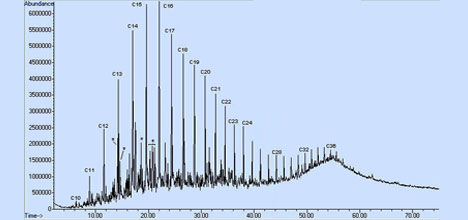University of Waikato scientists are studying the chemical composition of the fuel oil aboard the stricken container ship Rena.
The university's chemistry department has examined oil from the ship's tanks, from surface slicks and from ‘tar balls' found on Mount Maunganui Beach.
This graph shows the profile of compounds present in an oil slick sample collected 1.5 km south of the Rena. Straight chain hydrocarbon peaks are labelled. Other hydrocarbons and polyaromatic hydrocarbons (PAHs), including naphthalene and methyl naphthalenes, are interspersed between the labelled peaks.
Professor Alistair Wilkins says oil from the Rena grounding contains polycyclic aromatic hydrocarbon compounds (PAHs), which are known to be harmful to humans and wildlife.
'The levels of these compounds will likely determine when it is safe to eat shellfish and other marine species again.
'These hydrocarbon compounds are the same as those found in fuel oils from around the world, but we have yet to determine how much of each compound is present in the Rena oil.”
He says all the samples collected contain similar substances to those found in diesel fuel bought from the pump.
'However, the proportions of different sized compounds in the mixture are different, with Rena oil containing a greater proportion of larger compounds than diesel fuel.
'It is these large compounds that cause the fuel oil to have the consistency of Vegemite at room temperature.
'When the oil from the ship enters the water, the smaller, lighter compounds begin to evaporate, rather like paint drying, and the end result is a tarry solid such as we have seen deposited on the beach.”
Once on the beach, weathering and bacterial action will slowly degrade these deposits, but Alistair says it's not easy to predict how long this will take.
'Compounds have also been seen in the oil which may make it possible to distinguish Rena oil from local sources of oil using hydrocarbon ‘fingerprinting' techniques.”
Scientists will continue detailed analysis of the oil and it is expected that this information will assist researchers studying the effects of the spill on the coastal environment.



3 comments
OK then
Posted on 25-10-2011 17:59 | By jimmi
Did we not know this over 2 weeks ago, but I guess we have to keep our scientists happy, pity our tax dollars havent paid for them yet to find an answer, to pumping the bloody stuff faster.
RIGHTO
Posted on 25-10-2011 22:48 | By SCOTT NUFFIN4U
So we know what it in it and what is not, we also know that it is harmful to the environment, at least that is what it says above. Please tell me this is nothing new?
Hey Prof Alistair Wilkins
Posted on 26-10-2011 07:05 | By Demandthetruth
MNZ has had a product offered to them for 2 weeks that can overcome most of the toxic problems - there is a chemical scientist in Waikato ( obviously not working on this) who knows something about the product offered, and the Waikato Uni could be involved in it on a positive basis as part of the solution.
Leave a Comment
You must be logged in to make a comment.